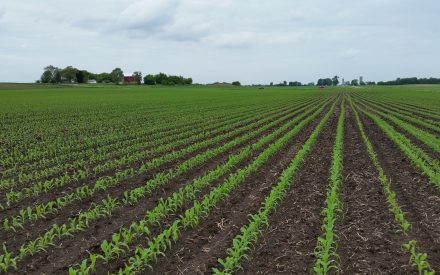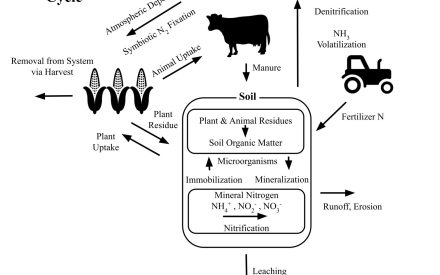Nitrate (NO3–), a form of Nitrogen (N), is a key nutrient input that fuels current agriculture. It is directly available for plant uptake, but it can also be leached through the soil into groundwater. Nitrate leaching occurs more easily in Central Wisconsin because of coarse-textured soils and the types of crops commonly grown in Central Wisconsin which generally receive large amounts of nitrogen. Soil nitrate can easily be lost to groundwater particularly after heavy rainfalls. In Wisconsin, most residents rely on groundwater as their primary water supply. High nitrate concentrations in drinking water present increased risks of cancer and methemoglobinemia, also known as Blue Baby Syndrome. Therefore, it is important to find ways to utilize N sources in agriculture efficiently and protect water quality and public health.
The Central Sands is one of the most nitrate-susceptible regions in Wisconsin. In Portage County, the most intensive vegetable production county in the Central Sands, 24% of private wells’ nitrate levels exceed the drinking water standard of 10 mg/L. One of the dominant N inputs in an agroecosystem is commercial nitrogen fertilizer. In the Central Sands, the seasonal N recommendation for potatoes (Russet Burbank) ranges from 145 to 250 lbs per acre depending on yield goals. However, high N input on sandy soils poses risks for nitrate leaching in vegetable production fields. Significant reductions of nitrogen leaching are key to reducing nitrate levels in groundwater. Nitrogen management practices are an important part of these reductions.
What are some opportunities to reduce overall impacts on water quality? Read this article which provides strategies to decrease N leaching in potato production systems and highlights some of the current UW research efforts to further understand these strategies.
Three production strategies to reduce N leaching in potato production include:
- Apply nitrogen use efficiency strategies, to meet potato needs and prevent N overapplication
- Plant and experiment with cover crops to minimize fall/spring nitrate leaching
- Diversify crop rotation to reduce overall N input
Improve Nitrogen Use Efficiency to prevent N overapplication
Improved nitrogen use efficiency either means growing the same amount with less nitrogen, or growing more with the same amount of nitrogen. The four basic considerations to deliver nitrogen efficiently boil down to the “4Rs”: Right Source, Right Rate, Right Time, and Right Placement.
Right Rate
To determine the correct N rate, test, and account for all N sources, which may include irrigation water N and N credits from previous crops.
Right Time
Of total season N application rates, apply 25–30% at emergence, 50–60% at mid-tuberization, and 10–25% at tuberization plus 3 weeks.
Right Placement
Seek creative ways to apply N fertilizer closer and more concentrated to the hills to increase N uptake in potatoes while reducing N leaching in the furrows.

Plant and experiment with cover crops to minimize fall and spring N leaching
Not all N fertilizer is uptaken by potato plants during the growing season. Shrestha et al. (2010) pointed out that the risk of nitrate leaching in a potato field is the highest late in the growing season after vine kill. After vine kill, potato tubers’ ability to uptake N decreases as it reaches full maturity. According to Figure 1, in August and September, the potato crop uses very little N from the soil, meaning unused nitrogen combined with precipitation leads to the peak nitrogen leaching risk period. Establish a cover crop as soon as possible after potato harvesting to realize more growing degree days for the cover crop and capture leftover N during the fall and the following spring. An additional benefit of establishing cover crops in the off seasons is enhanced soil health and reduced wind erosion, with living biomass contributing to these benefits for more of the year. Researchers are experimenting with interseeding cover crops between potato rows within the growing season to capture unused soil N. The goals are to manage the competition between the interseeded crop and potatoes; and to find the right species or mix of species that minimally competes with or potentially even enhances potato health and quality.
Diversify and extend crop rotations to reduce overall N leaching
Although most potato growers in the Central Sands implement a 3-year crop rotation (two crops between) involving potatoes, over 20% of potatoes in the Central Sands return within two years of previous planting (Heineman & Kucharik, 2022). Common rotational crops currently used are corn, sweet corn, and snap beans. To reduce overall N input, choose rotational crops with lower N requirements, such as alfalfa, peas, or beans. On top of choosing low-N rotational crops, extend the years between each potato crop. Consider a site prep year where a biofumigant such as mustard or millet is grown. Benefits include reduced soil-borne pathogen loads and increased soil carbon. With consumer and retailer demands for crops grown using innovative and regenerative agricultural practices, it’s strategies like these that need to be explored further. These strategies decrease weed and disease pressure, add carbon, in addition to other benefits that extend throughout the rotation. If benefits to water quality can be quantified and reductions in nitrate leaching are shown to be significant enough, the potential for growers to be rewarded for these practices by retailers and consumers is going to be much greater.
UW researchers are working on the management of nitrogen in the agroecosystem in the Central Sands to refine these recommendations and seek new strategies.
- Dr. Matt Ruark from the Department of Soil Science at UW-Madison is conducting on-farm trials monitoring crop N uptake under different N rates.
- Dr. Yi Wang from the Department of Horticulture is now developing a remote-sensing based tool to monitor site-specific variation of potato N status, in order to support in-season nutrient application decisions with the help of precision agriculture.
- Dr. Jed Colquhoun from the Department of Horticulture is also investigating innovative ways to incorporate cover crops into the potato agroecosystem.
- At UW-Madison, Dr. Chris Kucharik and PhD candidate Tracy Campbell from the Department of Agronomy are quantifying variability of nitrate in irrigation water applied to potato fields in the Central Sands.
- Dr. Jingyi Huang from the Department of Soil Science is developing low-cost nitrate sensors with potential to gather in-season fluctuations in nitrate levels at the root zone and groundwater.
- At UW-Stevens Point, Kevin Masarik from the Center for Watershed Science and Education is measuring nitrate leaching under potato rotations in the Central Sands and developing a Nitrogen Budget Calculator for field-specific nitrate leaching estimation.
Reduction of nitrogen leaching requires refining the current nitrogen management. Research in the Central Sands is important to understand nitrogen leaching dynamics and to refine existing and find new nitrogen reduction strategies.
References:
- Shrestha, Raj K., Leslie R. Cooperband, and Ann E. MacGuidwin. “Strategies to Reduce Nitrate Leaching into Groundwater in Potato Grown in Sandy Soils: Case Study from North Central USA.” American Journal of Potato Research 87, no. 3 (June 2010): 229–44. https://doi.org/10.1007/s12230-010-9131-x.
- Heineman, Emily Marrs, and Christopher J. Kucharik. “Characterizing Dominant Field-Scale Cropping Sequences for a Potato and Vegetable Growing Region in Central Wisconsin.” Land 11, no. 2 (February 11, 2022): 273. https://doi.org/10.3390/land11020273.
- Kucharik, Christopher J. and Tracy Campbell, “Improving Water and Nitrogen Use Efficiency Under Changing Weather Variability in The Central Sand”, Groundwater Research Report, WR18R001 (2020)

 ▶ Watch: Nitrate Leaching: Trends in the Midwest to Local Impacts in Wisconsin
▶ Watch: Nitrate Leaching: Trends in the Midwest to Local Impacts in Wisconsin Manage nitrogen as a budget to reduce groundwater contamination
Manage nitrogen as a budget to reduce groundwater contamination How much nitrogen is in your irrigation water?
How much nitrogen is in your irrigation water? A simple approach for on-farm Nitrogen budgeting
A simple approach for on-farm Nitrogen budgeting


